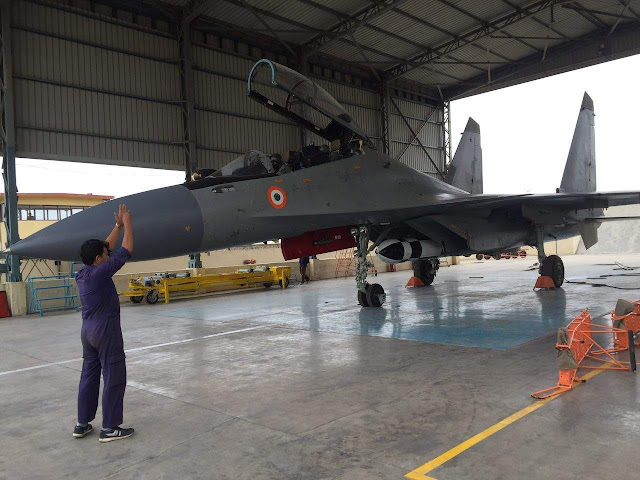BrahMos world’s fastest anti-ship cruise missile successfully test-fired from Sukhoi 30-MKI~ First for India, and the world
In a first for India, and the world, the Indo-Russian supersonic cruise missile BrahMos was today successfully test fired from IAF’s Sukhoi 30-MKI. BrahMos is one of the heaviest missiles in the world to be integrated on a frontline fighter jet and with today’s success, the IAF gets unprecedented fire power against the enemy.
“The missile was gravity dropped from the Su-30 from fuselage, and the two stage missile’s engine fired up and straightway propelled towards the intended target at the sea in Bay of Bengal,” said a Ministry of Defence release.
BrahMos, said to the world’s fastest anti-ship cruise missile, was integrated on the Sukhoi-30 MKI by HAL. With a range of 290-km, the 2.8 mach missile is a lethal weapon, and its integration with an aircraft like Sukhoi is without a doubt a big boost for India’s defence preparedness and strike capabilities. The success means the Air Force will now have the ability to strike hostile warships hundreds of kilometres off the coast in just minutes once ordered.
BrahMos, said to the world’s fastest anti-ship cruise missile, was integrated on the Sukhoi-30 MKI by HAL. With a range of 290-km, the 2.8 mach missile is a lethal weapon, and its integration with an aircraft like Sukhoi is without a doubt a big boost for India’s defence preparedness and strike capabilities. The success means the Air Force will now have the ability to strike hostile warships hundreds of kilometres off the coast in just minutes once ordered.
In 2016, a Sukhoi 30-MKI frontline fighter jet was test-flown with the BrahMos missile integrated on it. According to BrahMos Aerospace, the Su-30-BrahMos combination will carry out air combat operations within and beyond visibility range and will provide the IAF with the capability of attacking targets protected by powerful air defence assets. This means that BrahMos together with the Su-30 MKI would give India a formidable weapon against Pakistan.
BrahMos has already been inducted by the Indian Army and Indian Navy. It can be launched in either inclined or vertical configuration based on the type of the ship. The land-attack version of BrahMos is fitted on an mobile autonomous launcher. BrahMos is also capable of being launched from submarine from a depth of 40-50 metres. Several countries have already expressed interest in buying the BrahMos missile from India.
Incidentally, with India becoming a member of the MTCR, India and Russia decided to enhance the range of the BrahMos missile in 2016. In March this year, a 450-km land-based version of the BrahMos missile was successfully test fired. Meanwhile, the development of an almost 800-km range BrahMos missile is underway and is expected to be complete in two years time. The 800-km version will give China every reason to be wary of India’s strike capabilities.
The Indian Air Force variant test-fired today has significant differences from other versions of BrahMos. Unlike the Navy and Army version which are significantly larger in size and weigh three tonnes, the IAF version tested weighs 2.5 tonnes and has been adapted specifically for the Su-30 MKI fighter. Given the still considerable weight of the missile, the Su-30 can carry only missile one per mission.
A BrahMos armed Su-30 can fly 1,500 km in the direction of a hostile target out at sea. Using a special targeting mode in its radar, the Su-30 can lock onto an enemy warship and launch the BrahMos from long ranges, before it can be countered by surface-to-air missiles fired from the warship.
Post-launch, the Su-30 would fly away while the air-launched BrahMos uses its own seeker to home in on the target. Given its speed of Mach 2.8 (2.8 times the speed of sound), the BrahMos is extremely difficult to presently intercept by surface to air missiles deployed on leading warships around the world.
The combination of the Su-30 and BrahMos means that the Indian Air Force can deliver a knock-out punch in minutes if ordered, far quicker than a warship which may need to sail in the direction of a target out at sea.
The BrahMos missile is a joint Indo-Russian venture named after the rivers Moscow and Brahmaputra.


No comments:
Post a Comment